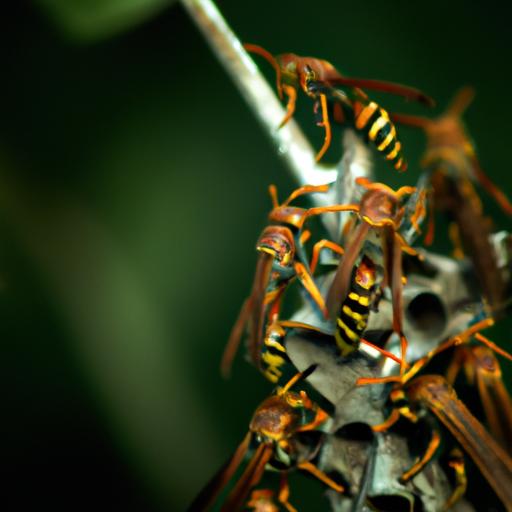Table of Contents
If you’ve ever come across a paper wasp, you might have wondered what they eat. Paper wasps are a common sight in most parts of the world, and they play an essential role in our ecosystem. However, very few people know what they eat and how their diet affects the environment. In this article, we’re going to explore the paper wasps’ diet, how they obtain their food, and the impact of their diet on the ecosystem.
Overview of Paper Wasps

Paper wasps are a type of social wasp that belongs to the family Vespidae. They are known for building their nests out of paper-like material, which is where they get their name. The nests are typically found in sheltered areas like eaves of houses, attics, or in trees. Paper wasps are usually yellow or brown with black stripes, and they can be identified by their thin waist and long wings.
Paper wasps are social insects that live in colonies. Each colony is led by a queen, who is responsible for laying eggs and reproducing. The colony also consists of female workers who are responsible for building the nest, gathering food, and caring for the young. Male paper wasps do not have stingers and do not play a significant role in the colony. They are only around to mate with the queen during the breeding season.
Paper Wasps’ Diet
Paper wasps are carnivorous insects, which means they feed on other insects and spiders. They are known to eat a wide range of prey, including caterpillars, flies, beetles, and crickets. The type of prey they eat depends on the availability and season. For example, during the spring and summer months, paper wasps feed on caterpillars, while in the fall, they switch to feeding on fruit and nectar.
Paper wasps obtain their food by hunting. They use their stingers to paralyze their prey, and then they carry it back to their nest to feed their young. The wasps also feed on nectar and fruit, which they collect using their long tongues. The nectar and fruit provide the wasps with the energy they need to hunt and care for their young.
Stay tuned for the next section, where we will discuss the types of food paper wasps eat and how they obtain their food.
Types of Food
Paper wasps are opportunistic predators that feed on a variety of insects and spiders. The type of prey they eat depends on the season and availability. Some of the most common prey that paper wasps feed on include:
-
Caterpillars: Paper wasps are known to feed on caterpillars during the spring and summer months. Caterpillars are a good source of protein and fat, which is essential for the growth and development of the wasp larvae.
-
Flies: Flies are a common food source for paper wasps. They are easy to catch, and they provide the wasps with the nutrients they need to survive.
-
Beetles: Paper wasps also feed on beetles, which are a good source of protein. They are known to hunt beetles that are larger than themselves.
-
Crickets: Crickets are another common prey that paper wasps feed on. They are easy to catch and provide the wasps with the nutrients they need to survive.
-
Spiders: Paper wasps are known to feed on spiders, which are a good source of protein. They are known to hunt spiders that are larger than themselves.
How They Obtain Their Food
Paper wasps obtain their food by hunting. They use their stingers to paralyze their prey, and then they carry it back to their nest to feed their young. The wasps are also known to scavenge for food, especially during the fall months when food is scarce. They are attracted to sweet-smelling fruit and nectar, which they collect using their long tongues.
Paper wasps are also known to be territorial when it comes to food. They will defend their food sources from other wasps and insects. This behavior is essential to ensure that their young receive enough food to grow and develop.
In conclusion, paper wasps are carnivorous insects that feed on other insects and spiders. They are opportunistic predators that feed on a variety of prey, including caterpillars, flies, beetles, crickets, and spiders. Paper wasps obtain their food by hunting and scavenging. Their diet plays an essential role in the ecosystem by controlling the population of other insects and spiders.
How Paper Wasps’ Diet Affects the Ecosystem
Paper wasps play a vital role in our ecosystem. By feeding on other insects and spiders, they help keep their populations in check. This, in turn, helps maintain a balance in the ecosystem. If the population of insects and spiders were to grow out of control, it could have devastating effects on our environment. Paper wasps also help pollinate flowers, which is crucial for the growth of many plant species.
However, paper wasps can also have a negative impact on the ecosystem. For example, they are known to prey on honeybees, which are essential for pollinating crops. This can reduce crop yields and affect the food supply. Additionally, if paper wasps build their nests in areas where people frequent, they can pose a danger to humans. Paper wasps will sting if they feel threatened, and their stings can be painful and cause an allergic reaction in some individuals.
Conclusion
In conclusion, paper wasps are carnivorous insects that feed on other insects and spiders. They obtain their food by hunting and also feed on nectar and fruit. Paper wasps play an essential role in our ecosystem by keeping the population of insects and spiders in check and helping to pollinate flowers. However, they can also have a negative impact on the ecosystem by preying on honeybees and posing a danger to humans. It’s essential to understand paper wasps’ diet to appreciate their role in our environment and take appropriate measures to ensure their coexistence with humans.